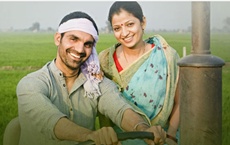2014: Financial inclusion opens new banking, insurance frontiers
30 Dec 2014
Banking and insurance services got a big boost in 2014, especially since the Narendra Modi-led government came to power in June this year, by bringing financial services closer to a majority of the so-far excluded sections of the population.
 While the ambitious Pradhan Mantri Jan Dhan Yojana (PMJDY) helped to ensure a bank account for each family of around 80 per cent of the unbanked population, the relaunched Varishtha Pension Bima Yojana (VPBY) will benefit the vulnerable sections of society with monthly pension ranging from Rs500 to Rs5,000 to senior citizens.
While the ambitious Pradhan Mantri Jan Dhan Yojana (PMJDY) helped to ensure a bank account for each family of around 80 per cent of the unbanked population, the relaunched Varishtha Pension Bima Yojana (VPBY) will benefit the vulnerable sections of society with monthly pension ranging from Rs500 to Rs5,000 to senior citizens.
Bank accounts have been opened for around 80 per cent of households even in the worst Naxal-infested Bastar division of Chhattisgarh under the PMJDY, while across the state, about 90 per cent families have been covered under the ambitious scheme.
The PMJDY scheme, launched by the prime minister on 28 August 2014, has been such a huge success that the target to opening 75 million accounts by 26 January 2015, has now been revised to 100 million.
As of 23 December 2014, about 99.1 million accounts have been opened under PMJDY and by 26 January 2015, the target of 100 million could easily be exceeded.
Under the PMJDY scheme, anyone who opens a bank account can get up to Rs1 lakh accidental cover, Rs30,000 life insurance cover and an overdraft facility of up to Rs5,000 if the bank account is active for six months and is linked to one's Aadhaar number.
In volume terms, however, this does not mean much for banks. Out of the over 96 million accounts opened till 18 December, about 74 per cent are zero balance. Banks have been able to mobilise only Rs7,340 crore. The cost of maintenance of the accounts for the banks, however, comes to Rs60-85 per account.
Right now, these accounts lie in the liability side of the banks' books. Only if transactions start happening will the banks benefit.
It is also too early to say how much of the financial inclusion target will be met through these accounts.
As of 1 December 2014, the states of Goa, Kerala, Tripura and Madhya Pradesh, Union Territories of Chandigarh, Puducherry and Lakshadweep have achieved 100 per cent saturation (in terms of coverage of all households with at least one bank account).
Union finance minister Arun Jaitley relaunched the Varishtha Pension Bima Yojana (VPBY), which will benefit the vulnerable section of society with limited resources and will provide monthly pension ranging from Rs500 to Rs5,000 per month to senior citizens of the country.
The revived scheme will remain open during the window stretching from 15 August 2014 to 14 August 2015 for the benefit of citizens aged 60 years and above, and will provide financial security by ensuring regular income during their advancing years. Like on the last occasion, the scheme will be administered by the LIC.
The subscription to the scheme is likely to create a corpus of more than Rs10,000 crore, and would thus also be a significant source of resource mobilisation for the development of the country. About 5 lakh senior citizens are likely to be covered under this scheme during the current year (2014-15).
Meanwhile, implementation of the direct benefit transfer (DBT) scheme to transfer cash or benefits directly to the beneficiaries' accounts, preferably Aadhar seeded, would help cut down several layers of the intermediaries in order to achieve timely and more frequent payments, target intended beneficiaries more accurately, remove fake, ghost beneficiaries and improve efficiency in delivery system.
This would also help create transparency and accountability in government delivery systems and empower beneficiaries.
Meanwhile, the RBI issued two new banking licences - one to IDFC Ltd, a financial services firm, and the other to Bandhan Financial Services Pvt Ltd, a Kolkata-based micro-lender - this year.
This was for the first time in a decade that banking licences were issued and these two banks are likely to start operations in 2015, but are not likely to pose much of a challenge to existing banks since the initial focus would be on aligning their portfolio as per RBI's requirement, and setting up operations.
New banks may not also mean cheaper loans and higher interest rates on deposits.
RBI has also issued final guidelines for payments and small banks. According to the guidelines, payments banks can open small savings accounts and accept deposits of up to Rs1 lakh per individual customer, and provide remittance services as well.
These banks can issue ATM or debit cards but not credit cards, nor can they lend. Payments banks can also distribute non-risk sharing simple financial products. Small banks will be allowed to take deposits as well as lend money, just like commercial banks, but the focus will be on small lending. The small and payments banks are expected to be rolled out in 2015.
RBI also issued the final guidelines for implementation of Bharat Bill Payment System (BBPS) in December. BBPS will be a centralised bill payment system that will allow people to use a single website or outlet to pay monthly or repetitive bills such as those for phone and electricity.
The one retrograde step, perhaps was the RBI move to allow banks charge customers for use of own ATMs - beginning 1 November, banks are allowed to charge customers transact more than five times a month at bank's own ATM, and this applicable across the country.
In metros, only three transactions will be free at other bank ATMs.
.webp)



.webp)


.webp)

























